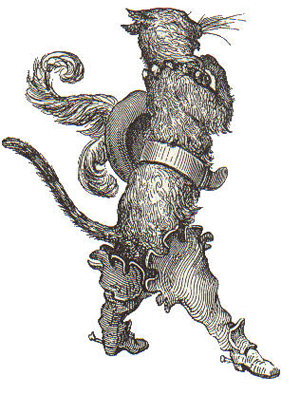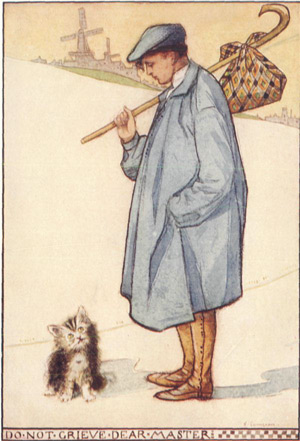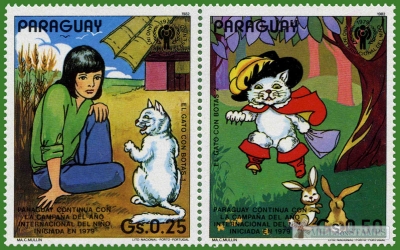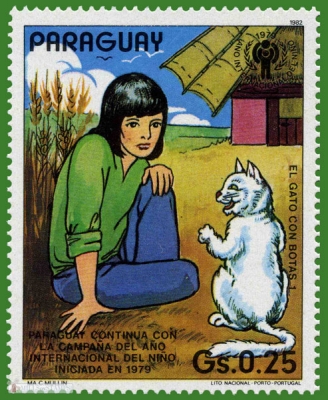-
International Year of the Child. Fairy tales: Puss in Boots
Paraguay 1982.04.16
In issue: Stamp(s): 7 Sheet(s): 1
-
Number by catalogue: Michel: 3482 Scott: 2030a
Perforation type: 14x14
Subject:
25 centimos. Scene from fairy tale of Charles Perrault* "Puss in boots"**. Logo of International Year of the Child (1979)***
Additional:
*Charles Perrault (12 January 1628 – 16 May 1703) was a French author who laid foundations for a new literary genre, the fairy tale, and whose best known tales include Le Petit Chaperon rouge (Little Red Riding Hood), La Belle au bois dormant (Sleeping Beauty), Le Maître chat ou le Chat botté (Puss in Boots), Cendrillon ou la petite pantoufle de verre (Cinderella) etc.
Perrault's most famous stories are still in print today and have been made into operas, ballets (e.g., Tchaikovsky's Sleeping Beauty), plays, musicals, and films, both live-action and animation.
Perrault was born in Paris to a wealthy bourgeois family, son of Pierre Perrault and Paquette Le Clerc.
Charles attended the best schools and studied law before embarking on a career in government service. He took part in the creation of the Academy of Sciences as well as the restoration of the Academy of Painting. When the Academy of Inscriptions and Belles-Lettres was founded in 1663, Perrault was appointed its secretary and serving Jean Baptiste Colbert's, finance minister to King Louis XIV. When Colbert died in 1683, he lost his pension as a writer.
In 1695, when he was 62, he lost his post as secretary. He decided to dedicate himself to his children and published Tales and Stories of the Past with Morals (Histoires ou Contes du Temps passé) (1697), with the subtitle: Tales of Mother Goose (Les Contes de ma Mère l'Oie). Its publication made him suddenly widely-known beyond his own circles and marked the beginnings of a new literary genre, the fairy tale. He had actually published it under the name of his last son (born in 1678), Pierre (Perrault) Darmancourt, (Armancourt was the name of a property he bought for him), probably fearful of criticism from the "Ancients".
In the tales, he used images from around him, such as the Chateau Ussé for Sleeping Beauty and in Puss-in-Boots, the Marquis of the Château d'Oiron, and contrasted his folktale subject matter, with details and asides and subtext drawn from the world of fashion. He died in Paris in 1703 at age 75.
**Puss in Boots (French: Le Chat botté – and it’s meaning "the cat with boots" or "the booted cat") is a European fairy tale, best known in the version collected by Charles Perrault in 1697 his Contes de ma mère l'Oye (Mother Goose Tales) as "The Master Cat".
The tale of a cat helping an impoverished master attain wealth through its trickery is known in hundreds of variants.
The fairy tale Synopsis:
The division of property after a miller's death leaves his youngest son with nothing but the granary cat. Disappointed, the son contemplates eating the animal, but the cat bargains with him, promising him riches in return for a bag and a pair of boots. Though dubious, the miller's son goes along with him and provides the items.
Puss-in-Boots takes the bag and catches a succession of items of game - rabbits, partridges, etc. - which he takes to the palace and presents to the king as presents from his master, the "Marquis de Carabas". Eventually the cat learns that the king and his beautiful daughter will be travelling by the river road. Puss-in-Boots tells the miller's son (who is ignorant of all this) to go and bathe in the river at the time that the royal party is due to pass. The boy does so, and as he bathes the cat steals his clothes, and runs to the road calling for help for his master, the Marquis de Carabas, who is drowning. The boy is "rescued" from the river, and his lack of clothes is explained as the work of robbers. He is therefore wrapped in rich robes and driven off in the king's coach.
The cat speeds ahead of the king's party to the lands of a powerful ogre. He threatens the people working in its fields that they will be chopped to bits if they don't say that the fields belong to the Marquis of Carabas. As the king's coach reaches the ogre's lands, the king asks after the ownership of the fields, and is told that they belong to the Marquis de Carabas. Puss-in-Boots goes ahead of the party, and confronts the ogre. He flatters the ogre on his magical shape-changing abilities and challenges him to turn into a mouse. The moment the ogre does so, Puss-in-Boots eats him, thus claiming the palace and lands in his master's name.
Upon reaching the ogre's palace, the royal party is welcomed by Puss-in-Boots in his master's name. The king marries the princess to the miller's son.
c.f. In Straparola's version, there is no ogre; the castle belongs to a nobleman who happened to die on a journey, and as consequence, the deceit is never revealed.
In Perrault's version, "Puss became a personage of great importance, and gave up hunting mice, except for amusement".
In Basile's and Jacobs's version, the miller's son had promised the cat to give him a funeral. The cat feigned death (in Basile's), or fell ill and looked dead (in Jacobs's). The miller's son went to throw the body in the trash. Angry, the cat rebuked him. In Basile's version, the cat, despite the pleas of the miller's son, left him; in Jacobs's, only after the miller's son summoned a doctor for her illness and pled with her did she agree to remain.

***UNESCO (United Nations Educational, Scientific and Cultural Organization) proclaimed 1979 as the International Year of the Child.
The proclamation was signed on January 1, 1979 by United Nations Secretary General Kurt Waldheim. A follow-up to the 1959 Declaration of the Rights of the Child, the proclamation was intended to draw attention to problems that affected children throughout the world, including malnutrition and lack of access to education. Many of these efforts resulted in the Convention on the Rights of the Child in 1989.Topics: Mills in Art Stylized mills Windmills



